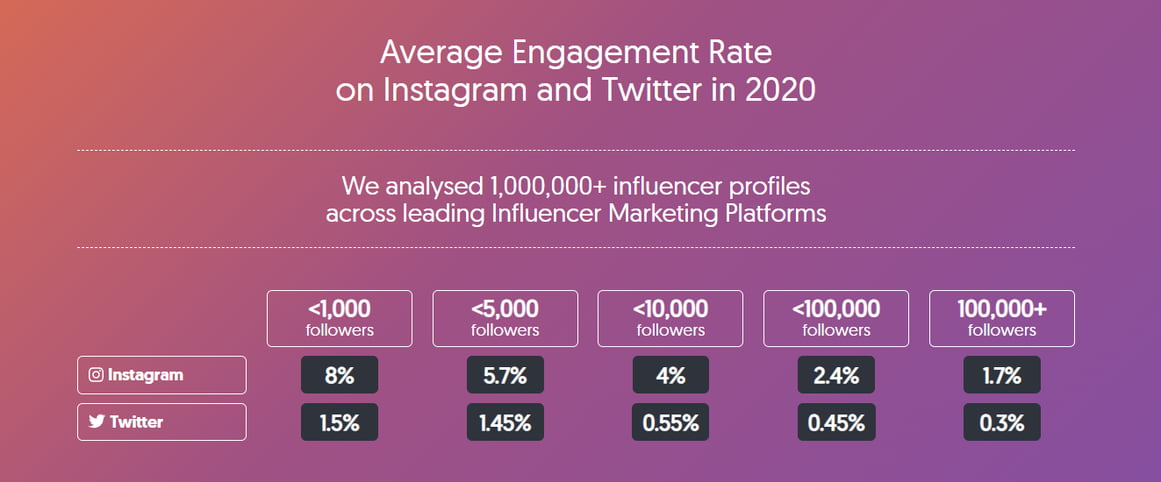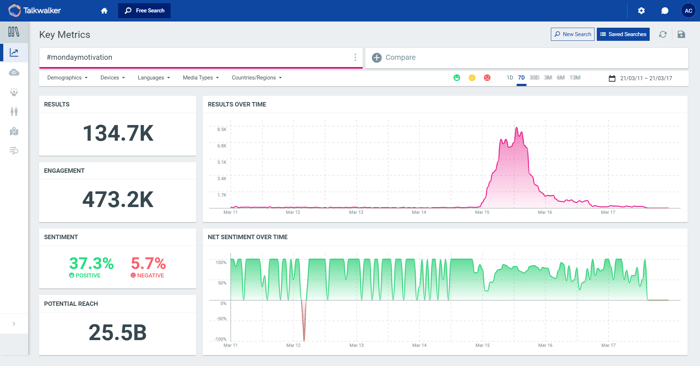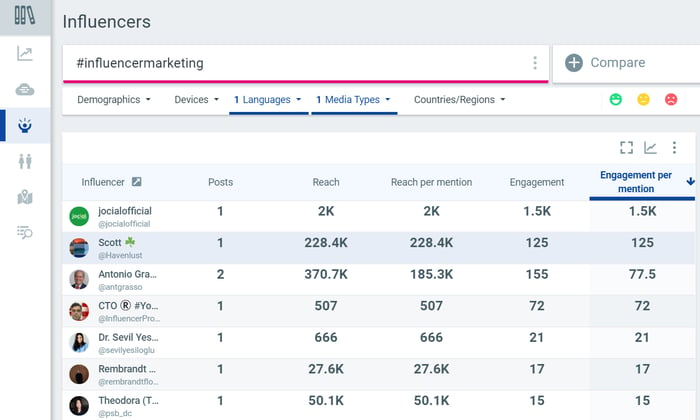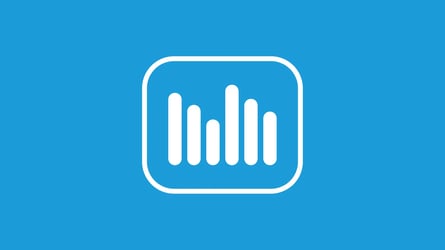Looking for a tool to identify influencers? Try Free Social Search
Micro-influencers get the best results for brands and businesses. According to a study by Experticity, 82% of consumers are “highly likely” to follow a recommendation made by a micro–influencer. In fact, micro-influencers have higher engagement rates compared to macro- and mega-influencers, and therefore generate better ROI. Here is a snapshot of engagement rates for different categories of influencers as per an analysis by Influencer Marketing Hub.
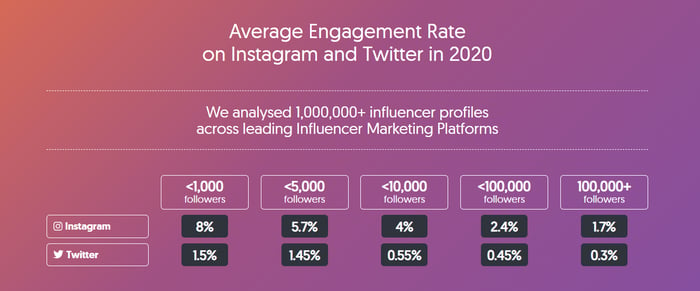
Engagement rate of influencers on Instagram and Twitter in 2020 as per a report by Influencer Marketing Hub
If you want a complete guide on launching a product with the help of micro-influencers, you can download this report. The report contains a framework for micro-influencer campaigns with examples and a campaign checklist.
Launching a product with micro-influencers
Now that you understand the importance of using micro-influencers in your marketing campaigns, here is a step-by-step guide on how to run a successful campaign with micro-influencers.
Set a goal for your campaign
Before you begin with your micro-influencer marketing campaign, the first step is to define your goals and create a strategy to achieve your goals. Make a list of what you want to achieve and how you will measure the success of your campaign. Here are a few examples of goals and KPIs that you can use:
Brand awareness - You could have a generic goal of creating more awareness for your brand. This can be measured with campaign reach, impressions, social media mentions, new followers, etc.
If you want to track the impact of your micro-influencer marketing campaign, you can try Free Social Search. It is a free social media monitoring and campaign tracking tool that allows you to understand and measure the impact of your campaigns and hashtags. You will get a unified view of your campaign and its performance. You can get deeper insights about your audience, sentiment data, and even compare your performance with your competitors.
Overview of social media reach, reactions, engagement and impressions for #MondayMotivation using Free Social search
Increase in traffic - If you want to drive more visitors to your website, you can measure the increase in traffic or unique visitors via your micro-influencer marketing campaign. If you are targeting your customers through specific landing pages, you could instead look at page views.
Lead generation - Lead generation is a common objective for many companies. People who register on your website to consume content are ‘hot’ leads and have a high potential of converting into customers.
Growth in sales - The end game of any campaign is to convert customers and drive revenue. However, if you focus on any of the above goals, you will achieve a growth in sales indirectly. Having said that, you can set up mechanisms to track the conversion of a customer from a micro-influencer campaign and the subsequent growth in revenue.
Select the right social media platforms
Once you’ve set your goals, the next step is to choose the platform on which you wish to run the campaign. Every platform has a different style and type of audience. To select the right platform, you must consider the following:
Target audience - Who is the target audience for your brand/product? Which platforms are they likely to be on? If you want to reach people between the age-group of 25 to 35, Instagram could be the best channel. On the other hand, if you are targeting businesses, LinkedIn is a more relevant platform for your company.
Here is an infographic that gives you a perspective on the demographic data of audiences on the top social media platforms:
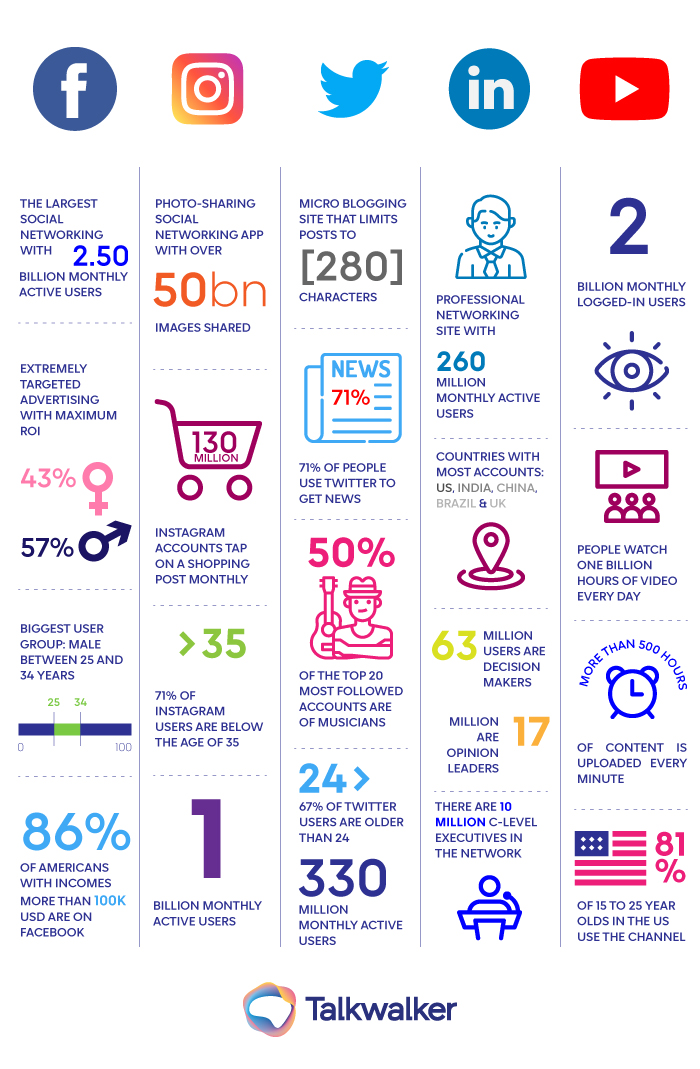
Demographic data of audiences on Facebook, Twitter, Instagram, LinkedIn & YouTube
Don’t always go after large social media networks. If you have a niche audience, you could consider promoting your brand on sites like BlogHer, Behance, Medium, etc. These sites have a specific group of people with particular interests. Depending on your target audience, choose the platform that best fits your goals and objectives.
Content type - Another consideration for selecting the platform is the type of content that you wish to promote. If you have visual content in the form of photographs or short videos, Instagram posts and Stories would work the best. For londer videos, you should opt for YouTube collaborations. If you are promoting a case-study or research document, you can look at LinkedIn.
Set a budget
Once you finalize the goals and platforms, the next step is to set a budget for your campaign. According to a research done by BigCommerce, 17% of companies spend over half their marketing budget on influencers. While most survey respondents (34%) said that they spend anywhere between 0-10% on influencer marketing.
The budget for your micro-influencer marketing campaign will depend on your product type and the ROI that you want out of it. In my opinion, you should start on a small budget and invest more if you see good results.
Create a content strategy
The next step is to create a content strategy for your campaign. To create a content strategy you need to consider your competitors, your industry and your product’s unique selling point. The influencer marketing landscape is extremely cluttered and you must differentiate your products and services from your competitors to stand out. Your potential customers need to know what makes your products better/different from others. Highlight the USP of your product to create a hook for your audience and cut through the clutter.
Create a mood board - To get the most out of your micro-influencer marketing campaign, create a mood board. This will help influencers better visualize your branding and style. Your mood board should contain colors, text, images and any other visual assets to communicate your brand identity and provide inspiration. This will not just ensure that you get better quality posts but also bring consistency and harmony to your overall campaign.
Identify the right influencers for your company/brand
The next step is to identify the right micro-influencers for your campaign. The best way to do so is to look for themes or hashtags that are relevant for your brand, and identify influencers that actively create content on those themes. You can use Free Social Search to make this process easy. Just enter the theme/hashtag in the search bar and navigate to the Influencer tab using the side menu. This tab will show you the list of influencers creating content on the searched topics. You can filter this list based on engagement rate, reach, number of posts, and more. You can also filter this list based on language, geography, media type, demographics and device type.
List of influencers who have created content using #influencermanagement on Twitter ranked according to engagement per mention (generated via Free Social search)
In addition to this, you can also look at your follower list to identify influencers. Your followers already understand your brand and will be the best evangelists for you. To identify the most valuable followers, use SocialRank. SocialRank will create a report to sort your followers based on their influence, follower count, or engagement metrics.
While selecting your micro-influencers look at their content carefully and ensure that it is in line with your brand and campaign message. Consider their following - number of followers, type of followers, engagement rate. Do they post regularly? Have they collaborated with other brands and companies in your industry? People who have collaborated with competitors or similar businesses can be a better candidate for your campaign!
Reach out to your micro-influencers
Once you have identified your micro-influencers, you can reach out to them via email, direct message or comments on social media. Here are the things that you should include in your outreach message:
- How you found them - Mention that you found their account while doing research on a certain topic and you found their content interesting.
- Reason for reaching out - Tell them that you are interested in collaborating with them for a time-bound campaign.
- Your product USP - Which product you would like them to endorse. How is this product different from competitors?
- Compensation - How will you reward them for promoting this product? Sometimes micro-influencers are happy to promote your brand in return for free products. However, you should inquire about the charges.
Measure campaign success
Once the campaign is over, you should measure the success of your efforts. Measure those goals that you have created against the new numbers. How have the metrics moved? Which influencers have helped drive maximum success? Measure the overall performance of the campaign and each influencer's individual contribution. This will help you identify the best candidates for your future collaborations.
Turn the top-performing posts into ads
Convert the best performing posts into ads to drive maximum engagement and conversions. Influencer mentions are a great way to build credibility and trust among prospect customers. Therefore, it is a good idea to extract the most out of these partnerships by pumping advertising budget. Instagram allows content creators to upload posts under 'paid partnership' which enables business partners to boost these posts.
Micro-influencer marketing can help you meet your business goals in an effective manner. It can help you attract potential customers as it is more authentic than self-promotion. This step-by-step guide should help you create and implement your first micro-influencer campaign successfully. Tell us what you think in the comments below.

